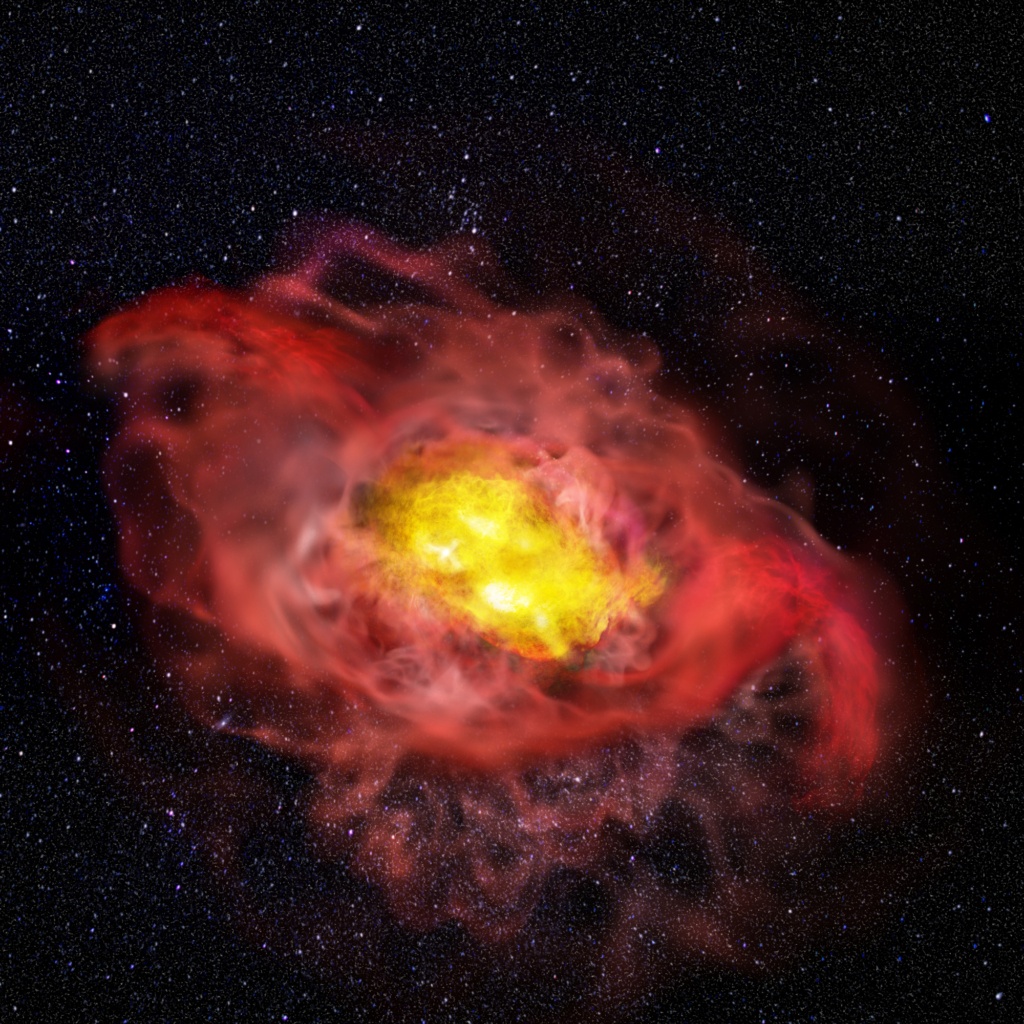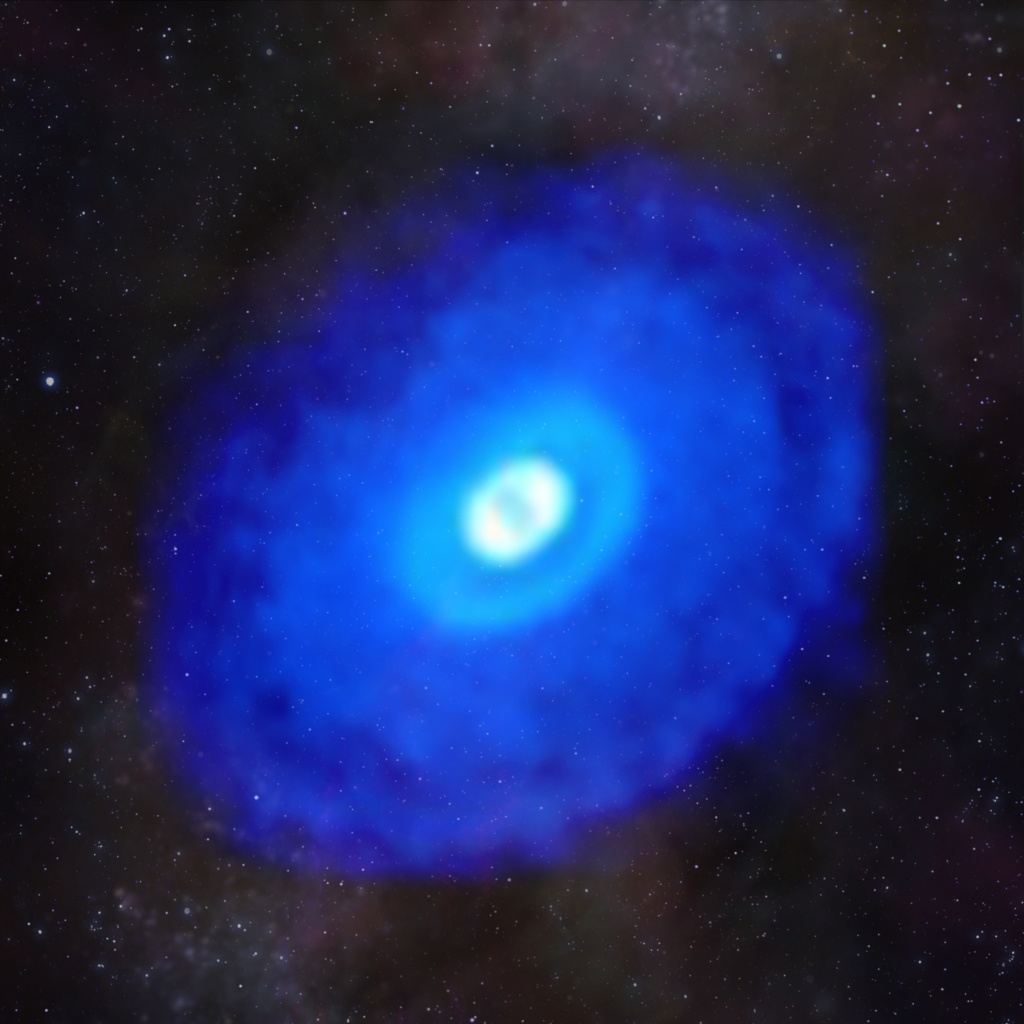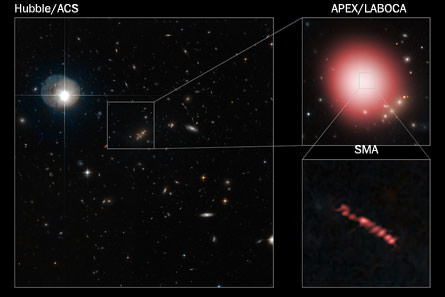A young galaxy with the catchy, roll-off-the-tongue name A1689-zD1 has experts in galactic formation talking. Recent observations show that this galaxy, seen as it would have looked just 700 million years after the Big Bang, is larger than initially believed, with significant outflows of hot gas from its core, and a halo of cold gas emanating from its outer rim. A1689-zD1 is considered representative of young ‘normal’ galaxies (as opposed to ‘massive’ galaxies), and the new observations suggest that the adolescence of normal galaxies may be more rambunctious than previous models suggest.
Continue reading “Once Again, Galaxies Look Surprisingly Mature Shortly After the Beginning of the Universe”Astronomers See Carbon-Rich Nebulae Where Planets are Forming
Understanding the birth of a planet is a challenging puzzle. We know that planets form inside clouds of gas and dust that surround new stars, known as protoplanetary disks. But grasping exactly how that process works – connecting the dots between a dust cloud and a finished planet – is not easy. An international team of astronomers is attempting to unlock some of those secrets, and have recently completed the most extensive chemical composition mapping of several protoplanetary discs around five young stars. Their research allows them to begin to piece together the chemical makeup of future exoplanets, offering a glimpse into the formation of new alien worlds.
Continue reading “Astronomers See Carbon-Rich Nebulae Where Planets are Forming”The Most Distant Massive Galaxy Observed to Date Provides Insight into the Early Universe
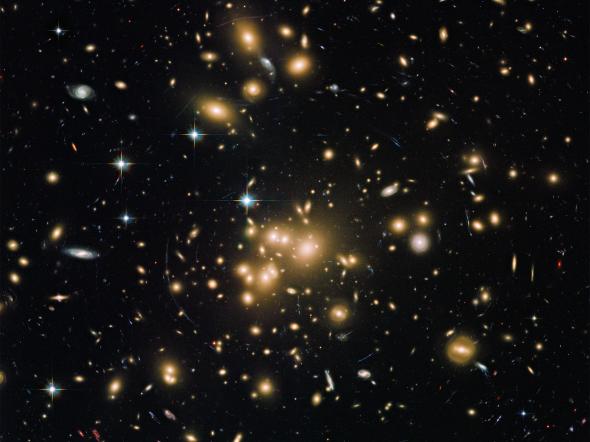
In their pursuit of learning how our Universe came to be, scientists have probed very deep into space (and hence, very far back in time). Ultimately, their goal is to determine when the first galaxies in our Universe formed and what effect they had on cosmic evolution. Recent efforts to locate these earliest formations have probed to distances of up to 13 billion light-years from Earth – i.e. about 1 billion years after the Big Bang.
From this, scientist are now able to study how early galaxies affected matter around them – in particular, the reionization of neutral atoms. Unfortunately, most early galaxies are very faint, which makes studying their interiors difficult. But thanks to a recent survey conducted by an international team of astronomers, a more luminous, massive galaxy was spotted that could provide a clear look at how early galaxies led to reionization.
The study which details their findings, titled “ISM Properties of a Massive Dusty Star-forming Galaxy Discovered at z ~ 7“, was recently published in The Astrophysical Journal Letters. Led by researchers from the Max Planck Institute for Radio Astronomy in Bonn, Germany, the team relied on data from the South Pole Telescope (SPT)-SZ survey and ALMA to spot a galaxy that existed 13 billion years ago (just 800 million years after the Big Bang).
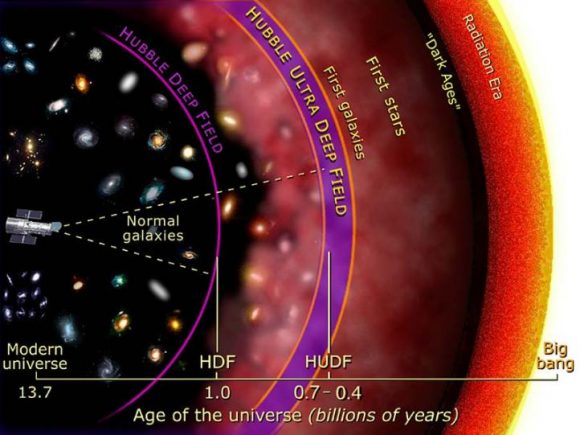
In accordance with Big Bang model of cosmology, reionization refers to the process that took place after the period known as the “Dark Ages”. This occurred between 380,000 and 150 million years after the Big Bang, where most of the photons in the Universe were interacting with electrons and protons. As a result, the radiation of this period is undetectable by our current instruments – hence the name.
Just prior to this period, the “Recombination” occurred, where hydrogen and helium atoms began to form. Initially ionized (with no electrons bound to their nuclei) these molecules gradually captured ions as the Universe cooled, becoming neutral. During the period that followed – i.e. between 150 million to 1 billion years after the Big Bang – the large-scale structure of the Universe began to form.
Intrinsic to this was the process of reionization, where the first stars and quasars formed and their radiation reionized the surrounding Universe. It is therefore clear why astronomers want to probe this era of the Universe. By observing the first stars and galaxies, and what effect they had on the cosmos, astronomers will get a clearer picture of how this early period led to the Universe as we know it today.
Luckily for the research team, the massive, star-forming galaxies of this period are known to contain a great deal of dust. While very faint in the optical band, these galaxies emit strong radiation at submillimeter wavelengths, which makes them detectable using today’s advanced telescopes – including the South Pole Telescope (SPT), the Atacama Pathfinder Experiment (APEX), and Atacama Large Millimeter Array (ALMA).
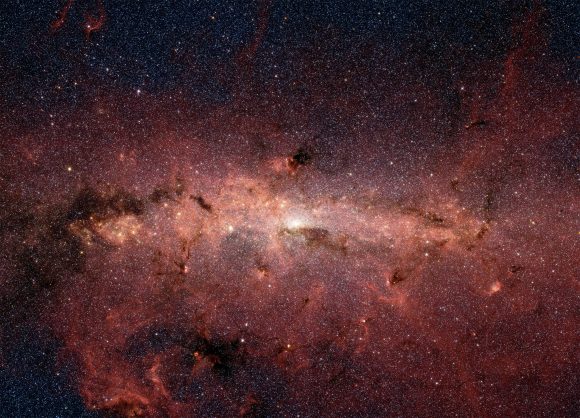
For the sake of their study, Strandet and Weiss relied on data from the SPT to detect a series of dusty galaxies from the early Universe. As Maria Strandet and Axel Weiss of the Max Planck Institute for Radio Astronomy (and the lead author and co-authors on the study, respectively) told Universe Today via email:
“We have used light of about 1 mm wavelength, which can be observed by mm telescopes like SPT, APEX or ALMA. At this wavelength the photons are produced by the thermal radiation of dust. The beauty of using this long wavelength is, that for a large redshift range (look back time), the dimming of galaxies [caused] by increasing distance is compensated by the redshift – so the observed intensity is independent of the redshift. This is because, for higher redshift galaxies, one is looking at intrinsically shorter wavelengths (by (1+z)) where the radiation is stronger for a thermal spectrum like the dust spectrum.”
This was followed by data from ALMA, which the team used to determine the distance of the galaxies by looking at the redshifted wavelength of carbon monoxide molecules in their interstellar mediums (ISM). From all the data they collected, they were able to constrain the properties of one of these galaxies – SPT0311-58 – by observing its spectral lines. In so doing, they determined that this galaxy existed just 760 million years after the Big Bang.
“Since the signal strength at 1mm is independent of the redshift (look back time), we do not have an a priori clue if an object is relatively near (in the cosmological sense) or at the epoch of reionization,” they said. “That is why we undertook a large survey to determine the redshifts via the emission of molecular lines using ALMA. SPT0311-58 turns out to be the highest redshift object discovered in this survey and in fact the most distant massive dusty star-forming galaxy so far discovered.”
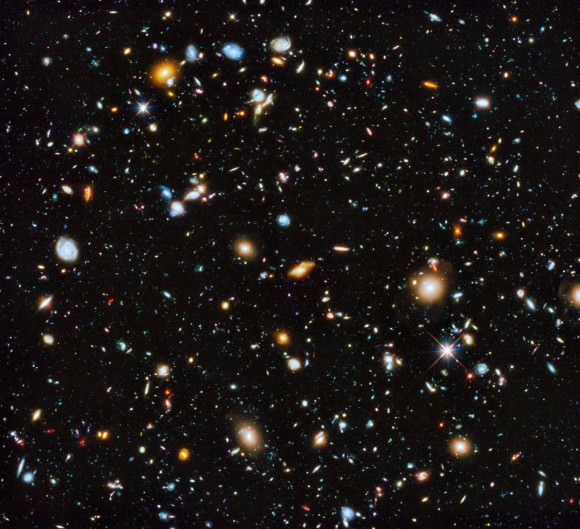
From their observations, they also determined that SPT0311-58 has a mass of about 330 billion Solar-masses, which is about 66 times as much as the Milky Way Galaxy (which has about 5 billion Solar-masses). They also estimated that it is forming new stars at a rate of several thousand per year, which could as be the case for neighboring galaxies that are dated to this period.
This rare and distant object is one of the best candidates yet for studying what the early Universe looked like and how it has evolved since. This in turn will allow astronomers and cosmologists to test the theoretical basis for the Big Bang Theory. As Strandet and Weiss told Universe Today about their discovery:
“These objects are important to understanding the evolution of galaxies as a whole since the large amounts of dust already present in this source, only 760 million years after the Big Bang, means that it is an extremely massive object. The mere fact that such massive galaxies already existed when the Universe was still so young puts strong constraints on our understanding of galaxy mass buildup. Furthermore the dust needs to form in a very short time, which gives additional insights on the dust production from the first stellar population.”
The ability to look deeper into space, and farther back in time, has led to many surprising discoveries of late. And these have in turn challenged some of our assumptions about what happened in the Universe, and when. And in the end, they are helping scientists to create a more detailed and complete account of cosmic evolution. Someday soon, we might even be able to probe the earliest moments in the Universe, and watch creation in action!
Further Reading: CfA, The Astrophysical Journal Letters
Greedy Galaxies Gobbled Gas, Stalling Star Formation Billions Of Years Ago
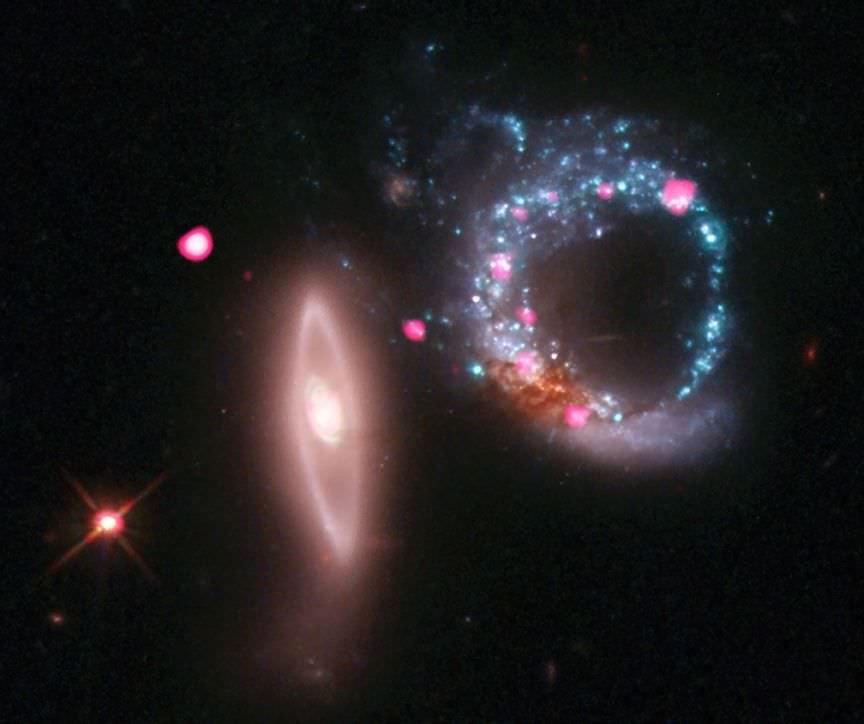
Like millionaires that burn through their cash too quickly, astronomers have found one factor behind why compact elliptical galaxies stopped growing stars about 11 billion years ago: they ate through their gas reserves.
The revelation comes as researchers released a new evolutionary track for compact elliptical galaxies that stopped their star formation when the universe was just three billion years old. When these galaxies ran out of gas, some of them cannibalized smaller galaxies to create giant elliptical galaxies. The “burned-out”galaxies have stars crowding 10 to 100 times more densely than elliptical galaxies formed more recently through a different evolutionary track.
“We at last show how these compact galaxies can form, how it happened, and when it happened. This basically is the missing piece in the understanding of how the most massive galaxies formed, and how they evolved into the giant ellipticals of today,” stated Sune Toft, who led the study and is a researcher at the Dark Cosmology Center at the Niels Bohr Institute in Copenhagen.
“This had been a great mystery for many years, because just three billion years after the Big Bang we see that half of the most massive galaxies have already completed their star formation.”
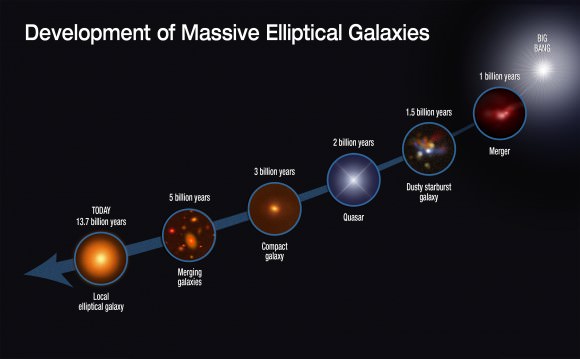
The team got a snapshot of these galaxies’ evolution by looking at a representative sample with the Hubble Space Telescope, specifically through the Cosmic Assembly Near-Infrared Deep Extragalactic Legacy Survey (CANDELS) and a spectroscopic survey called 3D-HST. To find out how old the stars were, they combined the Hubble work with data gathered from the Spitzer Space Telescope and the Subaru Telescope in Hawaii.
Next, they examined ancient, fast-star-forming submillimeter galaxies with data gathered from a range of space and ground-based telescopes.

“This multi-spectral information, stretching from optical light through submillimeter wavelengths, yielded a full suite of information about the sizes, stellar masses, star-formation rates, dust content, and precise distances of the dust-enshrouded galaxies that were present early in the universe,” Hubble’s news center stated.
The group found that that the submillimeter galaxies were likely “progenitors” of compact elliptical galaxies, as they share predicted characteristics of the ancestors. Further, researchers calculated that starbursts in submillimeter galaxies only went on for about 40 million years before the galaxies ran out of gas.
You can read the results in the Feb. 20 edition of the Astrophysical Journal or in prepublished version in Arxiv.
Source: Hubble News Center
ALMA Now a Full-Fledged Observatory
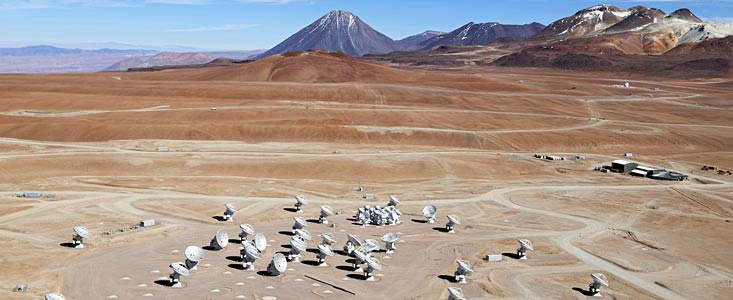
Today, in a remote part of the Chilean Andes, the Atacama Large Millimeter/submillimeter Array (ALMA), was inaugurated at an official ceremony. This event marks the completion of all the major systems of the giant telescope and the formal transition from a construction project to a fully fledged observatory. ALMA is a partnership between Europe, North America and East Asia in cooperation with the Republic of Chile.
ALMA is able to observe the Universe by detecting light that is invisible to the human eye, and will show us never-before-seen details about the birth of stars, infant galaxies in the early Universe, and planets coalescing around distant suns. It also will discover and measure the distribution of molecules — many essential for life — that form in the space between the stars.
ALMA’s three international partners today welcomed more than 500 people to the ALMA Observatory in the Chilean Atacama Desert to celebrate the success of the project. The guest of honour was the President of Chile, Sebastián Piñera.
In honor of the official inauguration of ALMA, this movie, called ALMA — In Search of Our Cosmic Origins, has been released:
The President of Chile, Sebastián Piñera, said: “One of our many natural resources is Chile’s spectacular night sky. I believe that science has been a vital contributor to the development of Chile in recent years. I am very proud of our international collaborations in astronomy, of which ALMA is the latest, and biggest outcome.”
The Director of ALMA, Thijs de Graauw, expressed his expectations for ALMA. “Thanks to the efforts and countless hours of work by scientists and technicians in the ALMA community around the world, ALMA has already shown that it’s the most advanced millimetre/submillimetre telescope in existence, dwarfing anything else we had before. We are eager for astronomers to exploit the full power of this amazing tool.”
The observatory was conceived as three separate projects in Europe, USA and Japan in the 1980s, and merged to one in the 1990s. Construction started in 2003. The total construction cost of ALMA is approximately US$ 1.4 billion.
The antennas of the ALMA array, fifty-four 12-metre and twelve smaller 7-meter dish antennas, work together as a single telescope. Each antenna collects radiation coming from space and focuses it onto a receiver. The signals from the antennas are then brought together and processed by a specialized supercomputer: the ALMA correlator. The 66 ALMA antennas can be arranged in different configurations, where the maximum distance between antennas can vary from 150 meters to 16 kilometers.
Source: ESO
Stunning Science Using Nature’s Telescope
[/caption]
Einstein started it all, back in 1915.
Eddington picked up the ball and ran with it, in 1919.
And in the last decade or so astronomers have used a MACHO to OLGE CASTLES … yes, I’m talking about gravitational lensing.
Now LABOCA and SABOCA are getting into the act, using Einstein’s theory of general relativity to cast a beady eye upon star birth most fecund, in a galaxy far, far away (and long, long ago).
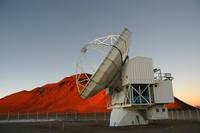
How galaxies evolved is one of the most perplexing, challenging, and fascinating topics in astrophysics today. And among the central questions – as yet unanswered – are how quickly stars formed in galaxies far, far away (and so long, long ago), and how such star formation differed from that which we can study, up close and personal, in our own galaxy (and our neighbors). There are lots of clues to suggest that star formation happened very much faster long ago, but because far-away galaxies are both dim and small, and because Nature drapes veils of opaque dust over star birth, there’s not much hard data to put the numerous hypotheses to the test.
Until last year that is.
“One of the brightest sub-mm galaxies discovered so far,” say a multi-national, multi-institution team of astronomers, was “first identified with the LABOCA instrument on APEX in May 2009” (you’d think they’d give it a name like, I don’t know, “LABOCA’s Stunner” or “APEX 1”, but no, dubbed “the Cosmic Eyelash”; formally it’s called SMMJ2135-0102). “This galaxy lies at [a redshift of] 2.32 and its brightness of 106 mJy at 870 μm is due to the gravitational magnification caused by a massive intervening galaxy cluster,” and “high resolution follow-up with the sub-mm array resolves the star-forming regions on scales of just 100 parsecs. These results allow study of galaxy formation and evolution at a level of detail never before possible and provide a glimpse of the exciting possibilities for future studies of galaxies at these early times, particularly with ALMA.” Nature’s telescope giving astronomers ALMA-like abilities, for free.
OK, so what did Mark Swinbank and his colleagues find? “The star-forming regions within SMMJ2135-0102 are ~100 parsecs across, which is 100 times larger than dense giant molecular cloud (GMC) cores, but their luminosities are approximately 100 times higher than expected for typical star-forming regions. Indeed, the luminosity densities of the star-forming regions within SMMJ2135-0102 are comparable to dense GMC cores, but with luminosities ten million times larger. Thus, it is likely that each of the star-forming regions in SMMJ2135-0102 comprises ~ten million dense GMC cores.” That’s pretty mind-blowing; imagine the Orion Nebula (M42, approximately 400 parsecs distant) as one of these star-forming regions!
James Dunlop of the University of Edinburgh suggests that such galaxies as SMMJ2135-0102 formed stars so abundantly because the galaxies still had plenty of gas – the raw material for making stars – and the gravity of the galaxies had had enough time to pull the gas together into cold, compact regions. Before about 10 billion years ago, gravity hadn’t yet drawn enough clumps of gas together, while at later times most galaxies had already run out of gas, he suggests.
But I’m saving the best for last: “the energetics of the star-forming regions within SMMJ2135-0102 are unlike anything found in the present day Universe,” Swinbank et al. write (now there’s an understatement if ever I’ve heard one!), “yet the relations between size and luminosity are similar to local, dense GMC cores, suggesting that the underlying physics of the star-forming processes is similar. Overall, these results suggest that the recipes developed to understand star-forming processes in the Milky Way and local galaxies can be used to model the star formation processes in these high-redshift galaxies.” It’s always good to get confirmation that our understanding of the physics at work so long ago is consistent and sound.
Einstein would have been delighted, and Eddington too.
Sources: “Intense star formation within resolved compact regions in a galaxy at z = 2.3” (Nature), “The Properties of Star-forming Regions within a Galaxy at Redshift 2” (ESO Messenger No. 139), Science News, SciTech, ESO. My thanks to debreuck (ESO’s Carlos De Breuck?) for setting the record straight re the name.
Youngsters Caught Gorging – on Gas
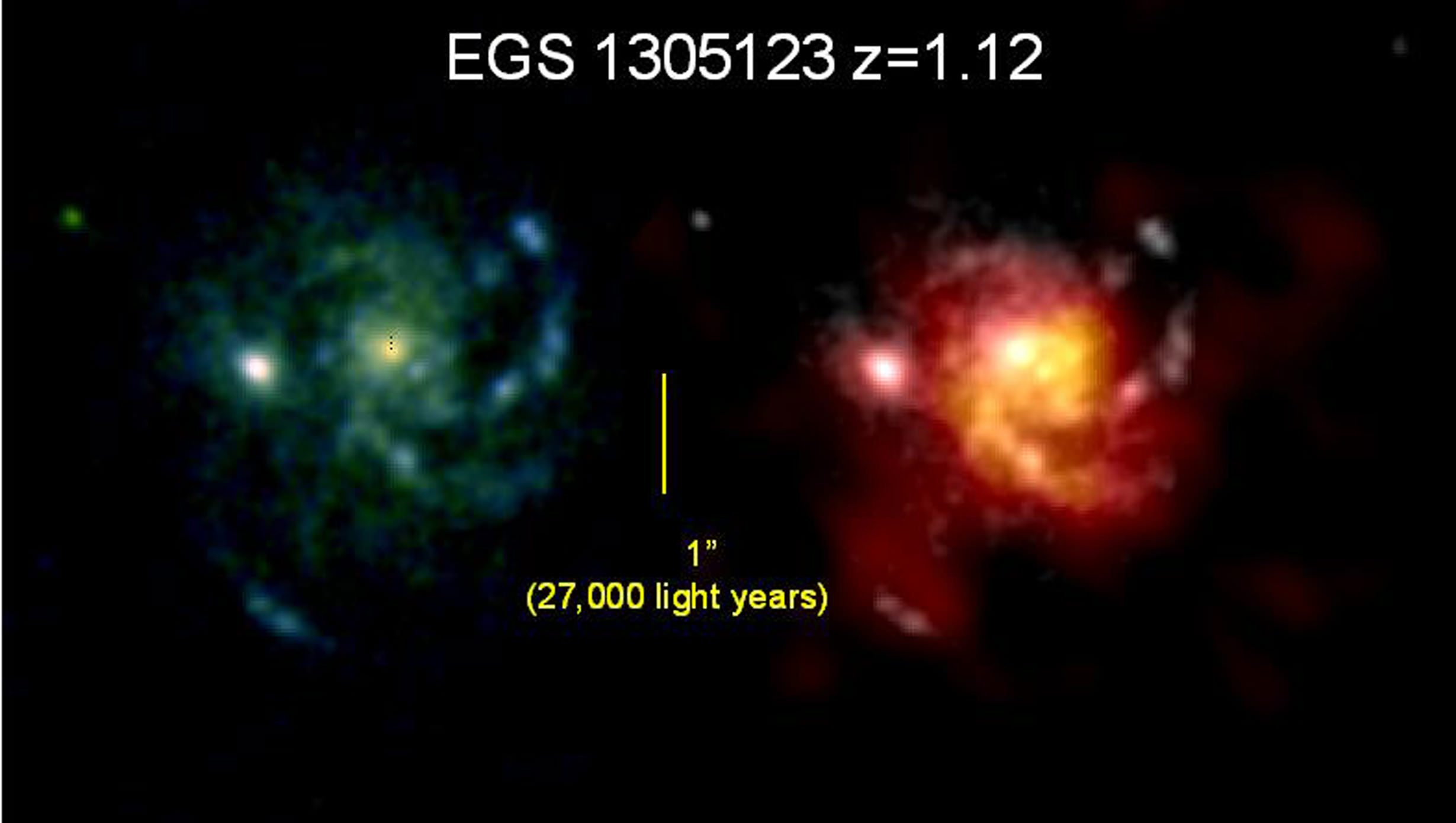
[/caption]
Galaxies long, long ago were very fecund; they gave birth to stars at a rate at least ten times what we see today.
Why? Was there more stuff around then, to make stars? Or were galaxies back then more efficient at star-making? Or something else??
Dr. Linda Tacconi, from Germany’s Max-Planck-Institut für extraterrestrische Physik, led an international team of astronomers to find out why … and the answer seems to be that young galaxies were stuffed to the gills with gas.
“We have been able, for the first time, to detect and image the cold molecular gas in normal star forming galaxies, which are representative of the typical massive galaxy populations shortly after the Big Bang,” said Dr Tacconi.
The challenging observations yield the first glimpse how galaxies, or more precisely the cold gas in these galaxies, looked a mere 3 to 5 billion years after the Big Bang (equivalent to a cosmological redshift z~2 to z~1). At this age, galaxies seem to have formed stars more or less continuously with at least ten times the rate seen in similar mass systems in the local Universe.
It is now reasonably well-established that galaxies formed from proto-galaxies, which themselves formed in local over-densities, dominated by cold dark matter – dark matter halos – where the newly neutral hydrogen and helium collected and cooled. Through collisions and mergers, and some on-going gas accretion, the proto-galaxies formed young galaxies, a few billion years after the Big Bang – in short, hierarchical formation.
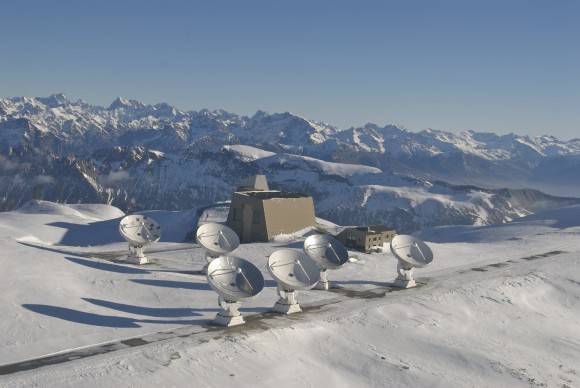
Detailed observations of the cold gas and its distribution and dynamics hold a key role in disentangling the complex mechanisms responsible for turning the first proto-galaxies into modern galaxies, such as the Milky-Way. A major study of distant, luminous star forming galaxies at the Plateau de Bure millimeter interferometer has now resulted in a breakthrough by having a direct look at the star formation “food”. The study took advantage of major recent advances in the sensitivity of the radiometers at the observatory to make the first systematic survey of cold gas properties (traced by a rotational line of the carbon monoxide molecule) of normal massive galaxies when the Universe was 40% (z=1.2) and 24% (z=2.3) of its current age. Previous observations were largely restricted to rare, very luminous objects, including galaxy mergers and quasars. The new study instead traces massive star forming galaxies representative of the ‘normal’, average galaxy population in this mass and redshift range.
“When we started the programme about a year ago”, says Dr. Tacconi, “we could not be sure that we would even detect anything. But the observations were successful beyond our most optimistic hopes. We have been able to demonstrate that massive normal galaxies at z~1.2 and z~2.3 had five to ten times more gas than what we see in the local Universe. Given that these galaxies were forming gas at a high rate over long periods of time, this means that gas must have been continuously replenished by accretion from the dark matter halos, in excellent agreement with recent theoretical work.”
Another important result of these observations is the first spatially resolved images of the cold gas distribution and motions in several of the galaxies. “This survey has opened the door for an entirely new avenue of studying the evolution of galaxies,” says Pierre Cox, the director of IRAM. “This is really exciting and there is much more to come.”
“These fascinating findings provide us with important clues and constraints for next-generation theoretical models that we will use to study the early phases of galaxy development in more detail,” says Andreas Burkert, specialist for star formation and the evolution of galaxies at Germany’s Excellence Cluster Universe. “Eventually these results will help to understand the origin and the development of our Milky Way.”
About the EGS 1305123 image: Spatially resolved optical and millimeter images of a typical massive galaxy at redshift z=1.1 (5.5 billion years after the Big Bang). The left image was taken with the Hubble Space Telescope in the V- and I-optical bands, as part of the AEGIS survey of distant galaxies. The right image is an overlay of the CO 3-2 emission observed with the PdBI (red/yellow colors) superposed on the I-image (grey). For the first time these observations clearly show that the molecular line emission and the optical light from massive stars trace a massive, rotating disk of diameter ~60,000 light years. This disk is similar in size and structure as seen in z~0 disk galaxies, such as the Milky Way. However, the mass of cold gas is in this disk is about an order of magnitude larger than in typical z~0 disk galaxies. This explains why high-z galaxies can form continuously at about ten times the rate of typical z~0 galaxies.
Sources: Max Planck Institute for Extraterrestrial Physics, Tacconi et al. (2010), Nature 463, 781 (preprint: arXiv:1002.2149)

